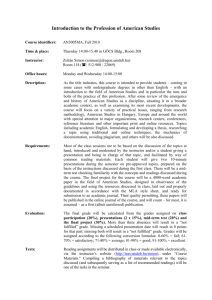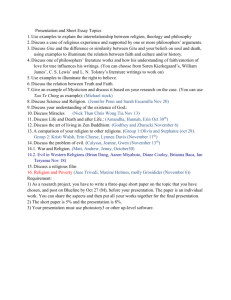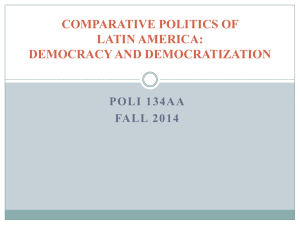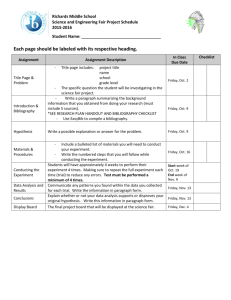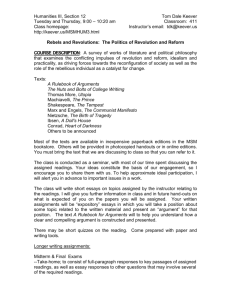Medical Microbiology Syllabus
advertisement
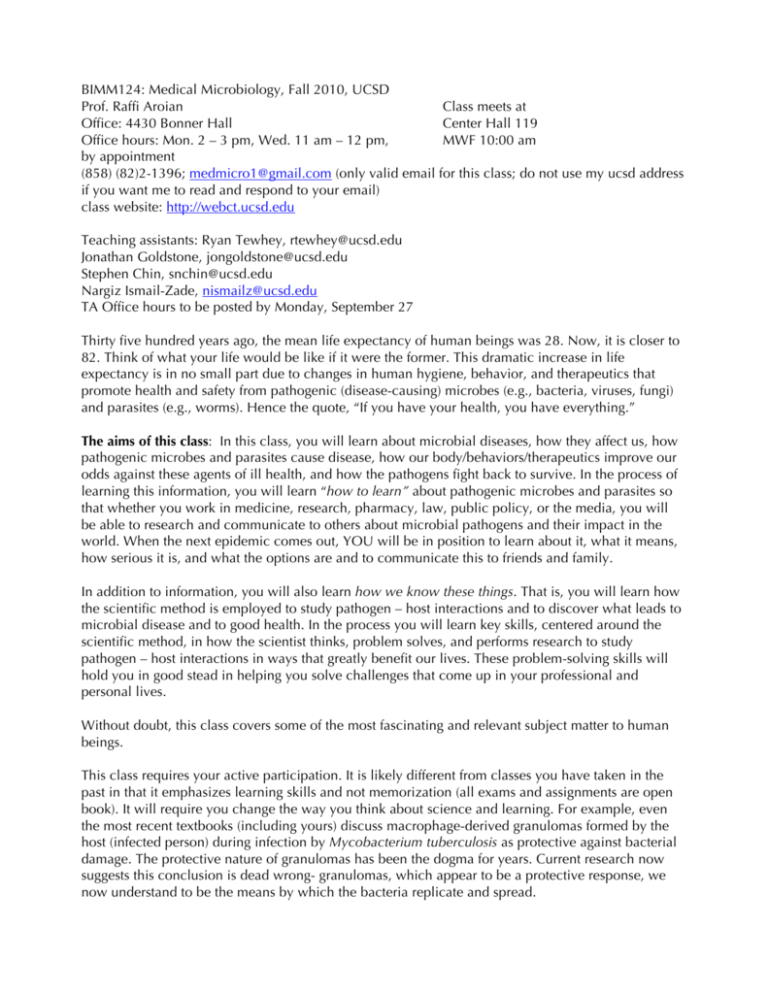
BIMM124: Medical Microbiology, Fall 2010, UCSD Prof. Raffi Aroian Class meets at Office: 4430 Bonner Hall Center Hall 119 Office hours: Mon. 2 – 3 pm, Wed. 11 am – 12 pm, MWF 10:00 am by appointment (858) (82)2-1396; medmicro1@gmail.com (only valid email for this class; do not use my ucsd address if you want me to read and respond to your email) class website: http://webct.ucsd.edu Teaching assistants: Ryan Tewhey, rtewhey@ucsd.edu Jonathan Goldstone, jongoldstone@ucsd.edu Stephen Chin, snchin@ucsd.edu Nargiz Ismail-Zade, nismailz@ucsd.edu TA Office hours to be posted by Monday, September 27 Thirty five hundred years ago, the mean life expectancy of human beings was 28. Now, it is closer to 82. Think of what your life would be like if it were the former. This dramatic increase in life expectancy is in no small part due to changes in human hygiene, behavior, and therapeutics that promote health and safety from pathogenic (disease-causing) microbes (e.g., bacteria, viruses, fungi) and parasites (e.g., worms). Hence the quote, “If you have your health, you have everything.” The aims of this class: In this class, you will learn about microbial diseases, how they affect us, how pathogenic microbes and parasites cause disease, how our body/behaviors/therapeutics improve our odds against these agents of ill health, and how the pathogens fight back to survive. In the process of learning this information, you will learn “how to learn” about pathogenic microbes and parasites so that whether you work in medicine, research, pharmacy, law, public policy, or the media, you will be able to research and communicate to others about microbial pathogens and their impact in the world. When the next epidemic comes out, YOU will be in position to learn about it, what it means, how serious it is, and what the options are and to communicate this to friends and family. In addition to information, you will also learn how we know these things. That is, you will learn how the scientific method is employed to study pathogen – host interactions and to discover what leads to microbial disease and to good health. In the process you will learn key skills, centered around the scientific method, in how the scientist thinks, problem solves, and performs research to study pathogen – host interactions in ways that greatly benefit our lives. These problem-solving skills will hold you in good stead in helping you solve challenges that come up in your professional and personal lives. Without doubt, this class covers some of the most fascinating and relevant subject matter to human beings. This class requires your active participation. It is likely different from classes you have taken in the past in that it emphasizes learning skills and not memorization (all exams and assignments are open book). It will require you change the way you think about science and learning. For example, even the most recent textbooks (including yours) discuss macrophage-derived granulomas formed by the host (infected person) during infection by Mycobacterium tuberculosis as protective against bacterial damage. The protective nature of granulomas has been the dogma for years. Current research now suggests this conclusion is dead wrong- granulomas, which appear to be a protective response, we now understand to be the means by which the bacteria replicate and spread. To succeed in this class, come to class having read the material. The material in the textbook will be the starting point of our discussions, not the end point. In addition, the lectures will make more sense to you, and you will be prepared for the exams and the assignments. You cannot cram learning how to read and acquire information but with practice you will learn how to do it better. Do all the assignments. They are structured so as to promote learning, promote success, and to empower you to take your learning and your learning outcomes into your hands as much as possible. Textbook (required): Schaechter’s Mechanisms of Microbial Disease, 4th Edition; note the final exam is open book but closed computer so possession of a hard copy of the book is required. Copies have been placed on reserved in the Biomedical Library. On-line textbooks (free via UCSD; you can print out relevant chapters): 1. Levinson’s Review of Medical Microbiology and Immunology, 11th Edition http://www.accessmedicine.com/resourceTOC.aspx?resourceID=519 2. Harrison’s Principles of Internal Medicine, 17th Edition http://accessmedicine.com/resourceToc.aspx?resourceID=4#404 3. Jawetz, Melnick, & Adelberg's medical microbiology, 24th Edition http://www.accessmedicine.com/resourceTOC.aspx?resourceID=6 Also required: clickers (iclicker). Register your clicker here: http://www.iclicker.com/registration. Access to a computer and printer is required for downloading assignments, relevant on-line chapters, etc… How we will achieve the aims of this class: 1. Informational readings. Each week you will be assigned readings from the textbooks (hard copy; electronic) and sometimes reviews from journal literature. Readings come from many different sources so that you can learn how to extract relevant information from multiple sources. These lay the foundation for our discussions, including basics of pathogenesis and immunity as well as clinical, epidemiological, and pathogenic aspects of the pathogens we will discuss. Typically, the first of two lectures on each pathogen will focus on this material. If you want to succeed in the class, come to class with having done the readings ahead of time. Come in with a list of questions that you have about the readings as that will often form the basis of our discussions on that day. In addition, during the final exam you may be asked to read new material from the book and apply the tools you have learned about it. Practice makes perfect! The goal is to help you learn to take active charge of your learning since once you leave UCSD, you will leave the lecture format of learning in the dust. We will also extract one or two salient points from these informational readings and, in the second lecture, learn how it is we know what we have read. 2. Primary literature readings. Virtually everything we know about microbial pathogenesis is based on research published in primary literature. Understanding “how we know” and “how we learn” about things biological is one of the most important skills I can teach you since you can apply this skill long after you leave UCSD. It will enrich your life in many ways. Each week, you will assigned primary literature to read and discuss in class. These primary literature readings will encompass some important themes regarding microbial pathogenesis, e.g., toxins (virulence factors), invasion/entry, circumvention and neutralization of the immune system, adverse immunological responses. These will be discussed in class, typically in the lecture immediately following the informational lecture, touching upon a subject brought up in this lecture. For each of these readings, I will supply instructions as to what to focus on in the reading in terms of your thinking. Doing these readings ahead of time is essential for you to learn how to read, think about, and work with research literature. Knowing how to do this influences a significant part of your grade since these tools will be used for your “Final Paper” that you will work on by yourself. In addition, you will need this skill on the exams Again, I want to give you ample opportunity to practice to succeed. You will also be assigned parts of three papers to discuss and present on in your sections (“Section Papers”). For these assignments, you will work in study groups from your sections to read and analyze the paper and then individually write-up brief, one-page answers to the questions regarding these papers. These play a role in your grade as outlined below. 3. Interactive classroom sessions that involve the use of iclickers and in-class discussions in which you (alone and in small groups) will be given a challenging question or scenario and work your way through to a solution (usually indicated by clicker voting). iclickers will also be used to help me assess the comprehension or readings and materials, showing areas where more attention is called for. They may also play a positive role in your grade, if you so choose. 4. Sections. Sections are mandatory for this class and play a significant role in reinforcing and strengthening your analytical skills. Sections will cover new material required for the final exam and final paper and not covered during regular lectures. They are also where your Section Papers are discussed and graded. You must be present to receive a grade on your Section Papers. In section you will also find your study group that you will work with on primary literature readings (e.g., Section Papers) and your debate presentation. To enroll in section, go to http://sections.ucsd.edu/. There is a limit of 30 students per section. Enrollment starts the first day of class at 6 pm and continues for one week (Oct 1, 6 pm). Sections are: A01, Monday 1-1:50 pm, CSB 004 A02, Wednesday 3-3:50 pm, CENTR 217A A03, Wednesday 7-7:50 pm, WLH 2112 A04, Thursday 5-5:50 pm, HSS 1315 A05, Friday 9-9:50 am, WLH 2209 A06, Friday 1-1:50 pm , CENTR 201 How the class will be evaluated: 1. Exams. There are two exams in this class, a take-home midterm and an in-class final exam on Friday, December 10, 8-11 am. Both are cumulative, open book, and open notes. No electronic media (cell phones, computers, calculators, etc..) are allowed. They will emphasize problem-solving skills and being able to think about and extrapolate information from readings. Both will be in the same format. The midterm will be graded and handed back to you. This grade will give you an idea of the grade you are receiving in the class. The midterm exam grade will be replaced by the final exam grade after the final has been taken. The final exam is worth 50-70% of your grade, depending upon your own choices. A final worth 50% of your grade is normal for most classes. Thus, depending on your choices, the final is worth no more than any other class you are likely to take. The advantage of having this system is that the midterm is in essence a practice final exam in which you can experience what the final exam is like without the pressure of having it count. Our goal- help you succeed. The final will be graded on a standard scale (not on a curve) so that everyone has the opportunity to achieve a high grade and so that the final exam does not become a competition. To help achieve fairness (e.g., in the event the final exam turns out to be more difficult than anticipated), 100% on final exam will be normalized to the average of the top 5 grades in the class. There is no regrading of the final exam except where incorrect addition of points in the exam resulted in an incorrect score. I realize you may have many finals. Please look at your finals’ week schedule now. If the timing of this final conflicts with other finals, then you need to either drop the conflicting class or this class. Writing a fair exam that tests problem solving abilities and the skills we are looking to develop in class takes a lot of effort. Therefore there are no make-up finals and no early finals. Due to the constraints of so large a class and our ability to write and grade the final, to get credit for the final exam you must take it at the scheduled time except under extraordinary documented circumstances (e.g., documented illness that requires hospitalization), and I must be notified of that extraordinary circumstance prior to the final. Makeup finals may be an oral presentation to the instructor. 2. Final Paper on a piece of primary literature due on the final week of class. 30% of your grade. The format of these papers and what will be expected from the students will be made explicitly clear when the papers are assigned on Nov 8. You are to work on these individually and are expected to do your own thinking and writing. They are due in class on Nov 29 (3 weeks later) and will be graded (standard letter grade, not curved) according the handout that will accompany them (similar to your primary literature paper assignments leading up to this). To get full credit for your work your must hand your assignment in on time. If you hand them in late, there will be several unavoidable consequences. One is, we may not be able to find time to grade it (which would result in a zero) because we have scheduled time to grade these and cannot let the grading go into finals week. The second is your peers will (justly) complain to us that it is unfair that someone got to hand their paper in late when they handed theirs in on time. The third is your education and peace of mind will probably suffer since you will be piling on your workload before finals week. If, for whatever reason, you cannot meet this deadline please email your section TA and me before the due date. There is no regrading of the discussion paper. 3. Clickers, optionally 10% of your grade: At the beginning of each lecture and then during lecture, I will present small, multiple-choice questions that will challenge your thinking and comprehension of material just presented and that provide opportunities for problem solving on a smaller scale, individually and in groups. These questions will also provide important and immediate feedback to me as to how the learning process is progressing. To make this form of feedback and learning work, I want every member of the class to purchase and bring with them a clicker. Each class with a clicker question to test reading comprehension of the material that day. By answering 75% of the clicker questions (right or wrong, it doesn’t matter), you will receive 10% of your grade as an A. Below this level of participation, you will receive no credit and instead that 10% of your grade will be switched to the final. The idea is encourage active in-class learning—showing up, thinking about the problems, and participating in problem solving. This approach is also true to science itself, which is a dynamic and participatory process, not an isolated one or one that is carried out via mass media. Needless to say, use your own clicker only (see Section on Academic Integrity). 4. Section Papers, optionally 10% of your grade: There are three write-ups on primary literature due in Section, graded in section, and discussed in section. These will be written up according to instructions given with each paper and are to be no longer than 1 page in length. You are to work on reading and discussing these assignments in your study groups (assigned in section) and then write up your own answers individually. The reason working in groups is that experience has shown that students learn more about reading, interpreting, and understanding primary literature when in a group. You are to bring your write ups to section, where they will be discussed and graded. You must be present in section to get credit for your Section Paper. For each Section Paper, you will receive either an “S” (satisfactory), “U” (unsatisfactory), or “N” (not done). The questions for these papers will mirror those in the exams. For each Section Paper you receive an “S” on, you will receive 3.33% of your grade as an A. Whichever ones you do not pass, that part of your grade will transfer to your final. In general, to get and “S” you must receive a 75% or greater on your Section Papers. Thus, if you both do clickers and pass your Section Papers, then you will have 20% of your grade already as an “A” and your final will be worth 50% of your grade. In this way, you are empowered to make a difference in your grade. Instructor/instruction evaluations: Periodically, students will be asked to fill out evaluations on index cards at the end of class to help us evaluate the effectiveness of instruction and the instructor. Grades Course grades will be assigned as follows: A: 85-100%; B: 75-85%; C: 60-75%; D: 45-60%. Academic Integrity: Academic dishonesty undermines the hard work of all the students in the class who are engaged in the learning process and who are taking responsibility for their learning. It is also incompatible with the practice of science and search for the truth. I will not tolerate it. Out of respect and appreciation for your own efforts, you should not tolerate cheating among your colleagues either, and I encourage you to talk with any of the BICD110 staff if you learn of any incidents of academic dishonesty. If I suspect dishonesty, I will meet with you to discuss my concerns, and I will report the incident to the Biology Undergraduate Affairs office and to your college Dean. The following is an excerpt from the UCSD General Catalog on Academic Dishonesty: ”Each student is responsible for knowing and abiding by UCSD's policies on Academic Dishonesty and on Student Conduct. Any student violating UCSD's Academic Dishonesty or UCSD's Student Conduct policies will earn an 'F' in the course and will be reported to their college Dean for administrative processing. Committing acts that violate Student Conduct policies that result in course disruption are cause for suspension or dismissal from UCSD.” Use of two or more clickers in the class (ie clicking in for someone else) will be treated as a violation Student Conduct Policies. How to succeed in this class: 1. spend the 8 hours outside of class time expected for a 4 unit class. Read the textbook and papers before class (~5 hr) and prepare for sections (readings, Section Papers) (~3 hr). Students who do the work and come prepared to class do better! 2. attend lectures and attend sections. I have run the statistics. Students that are present in class and students that are present in section statistically do significantly better than those that are not. 3. ask questions whenever something in not clear, either before/during/after class, during my office hours (please come!), during TA office hours, in sections. 4. participate with your clicker, be interactive with the material 5. do all the assignments—do the Section Papers. Whether you get “S” or not, you will learn a lot in the process. Take the Midterm. It will challenge and stimulate your learning and give you excellent practice for the final. 6. talk with me and/or your TA’s about any difficulties you are having with assignments, with understanding the material, with reading primary literature, with problem solving techniques. Let us know as soon as you are able how we can help you learn. 7. Study in groups. Reading primary literature is challenging when you are not used to it. I strongly urge you to read and discuss the papers you are reading in groups. These groups will be set up in the first full week of class in sections. CLASS ETIQUETTE 1. The best place for learning is up front in the active learning zone. 2. Come on time. If you come late, please sit in the back so as to not disturb others. 3. Be present in the class. That means all cell phones off, please. No texting, no phone calls. It is disruptive to other students and to your instructor. Medical Microbiology Class and Section Schedule, Fall 2010; all readings and assignments subject to change; SMMD = Schaechter’s Mechanisms of Microbial Disease Date/Lecture topic Readings Section topic for week Assignment-- available on website by 4 pm Thursday September 24 (M); logistics N/A Sign up for section None Sept 27 (M); Introduction to Infectious Diseases SMMD: Chapters 1-2; Chapter 3 pp. 18-27 Study groups assigned; Koch’s postulates Paper section write-up; due in Sections next week Sept 29 (W); Normal flora Cash et al. paper; Fig. 1AB, 2A, 3A Review/grade section write-ups SMMD: Chapter 8 Parasite’s Way of Life Paper section write-up; due in Sections next week Review/grade section write-ups Take-home midterm; due Monday in class Oct 1(F); Innate Immunity I Oct 3 (M); Innate Immunity II; Adaptive Immunity I SMMD: Chapter 6 SMMD: Chapter 7 Oct 5 (W); Adaptive Immunity II -- Oct 7 (F); Adaptive Immunity III Oct 11 (M); Bacterial toxins; Damage-response framework paper TBD SMMD: Chapter 9; Damage Response paper pages 1-4 Oct 13(W); Staphylococcus aureus I SMMD: Chapter 11; Levinson on-line Chapter 15 section on “Staphylococcus” or review article Oct 15(F); S. aureus II Oct 18 (M); Streptococcus pneumoniae I paper TBD SMMD: Chapter 13; Levinson on-line Chapter 15 section on “Streptococcus pneumoniae” or review article Oct 20 (W); S. pneumoniae II paper TBD Oct 22 (F); Salmonella enterica I SMMD: Chapter 17, 208214; Harrison on-line Chapter 146 or review article Oct 25(M); Salmonella enterica II paper TBD Oct 27(W); special fun lecture to be announced -- Oct 29(F); Mycobacterium tuberculosis I Nov 1(M); M. tuberculosis II SMMD: Chapter 23; Levinson on-line Chapter 21 or review article paper TBD Nov 3(W) Viral pathogenesis I SMMD: Chapter 31 Nov 5(F) Guest lecture—Dr. Victor Nizet Streptococci and Staphylococci Nov 8(M) Viral pathogensis II SMMD: Chapter 12 Nov 10(W) Influenza I SMMD: Chapter 36; Jawetz et al on-line Chapter 39 or review article Nov 12(F) Influenza II Nov 15(M) Measles, Mumps, Rubella I paper TBD SMMD: Chapter 34 (measles only); Jawetz online Chapter 40 (Mumps, Measles and Rubells only) or review article Nov 17(W) MMR II paper TBD (granulomas) Nov 19 (F) Special in-class debate on the MMR vaccine and autism Nov 22(M) HIV I -- Nov 24(W) HIV II -- Nov 26(F) Thanksgiving break Nov 29(M) Opportunistic Fungi (KGB Memorial Lecture); final papers due in class paper TBD SMMD: Chapter 48; maybe review article Dec 1(W) Helminths SMMD: Chapter 54; paper TBD Dec 3(F) Guest lecture—Dr. Joseph Vinetz Malaria SMMD: Chapter 52 pp. 489-495 -- SMMD: Chapter 38; Jawetz on-line Chapter 44 or review article Review midterm Paper section write-up; due in Sections next week Review/grade section write-ups SMMD: Chapter 45 Vaccines Final paper project announced November 8; debate papers General review None No sections; Thanksgiving break None General review None
